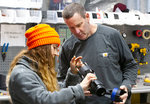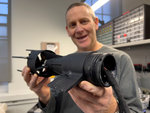Industry-leading aquatic robots: Made in Bristol
Jaia Robotics specializes in developing micro-sized autonomous marine vehicles called JaiaBots. They look like small red missiles, but they’re actually powerful aquatic data collection devices.
This item is available in full to subscribers.
Please log in to continue |
Register to post eventsIf you'd like to post an event to our calendar, you can create a free account by clicking here. Note that free accounts do not have access to our subscriber-only content. |
Day pass subscribers
Are you a day pass subscriber who needs to log in? Click here to continue.
Industry-leading aquatic robots: Made in Bristol
For well over a century, little Burnside Street has been a global center of marine innovation, first as the home of the Herreshoff Manufacturing Company. Now, it’s the site of the Herreshoff Marine Museum’s new Blue Tech Innovation Center, which is ushering in a new kind of marine innovation. Their very first tenant, Jaia Robotics, is up and running and filling a niche need with applications for industries from climate science to defense.
Jaia Robotics specializes in developing low cost, micro-sized autonomous marine vehicles called JaiaBots. They look like small red missiles, about two feet long. But JaiaBots aren’t missiles, they’re aquatic data collection devices that are affordable, easy to operate, rugged and reliable, and require minimal user training to harness their wide-ranging capabilities. They can work alone or in swarms, collecting data 100 miles offshore at depths of 100 meters.
Jaia was founded by Ian Estaphan Owen and Jason Webster in the middle of the pandemic, with Owen working from his Jamestown bedroom and Webster from his Wareham garage. They didn’t so much settle on a name as grasp for it, immediately following their first pitch to a potential investor.
“We looked at that opening slide and it just said Jason co-founder, Ian co-founder….there was no name,” said Owen. Jaia, a mash-up of the first two letters of their first names, was what they came up with in the five minutes before their pitch. They didn't think it would stick, but then they Googled it. It turns out that Jaia, in Sanskrit, means victorious. “Ok, that’s kind of cool, we thought,” said Owen. “I thought we would change the name in the weeks ahead, but it's stuck and it's done us well.”
Rapid growth
Owen and Webster met when both worked previously for a company that produced a robotic swarm product, but one that had significant problems. When the company failed in December 2020, it opened up that market for making small autonomous surface underwater data collection vehicles, but Owen and Webster knew they had to start from scratch. “We started with a blank sheet of paper,” said Owen. They kicked off product development on March 13, 2021 and had their first prototype in the water September 16, 2021 — all during Covid with nobody in the same office.
The goal of the company is to democratize aquatic data collection by making underwater vehicles that could work in teams and cover large areas very quickly, very efficiently and at very low cost relative to anything else. Owen and Webster took their idea from a blue tech accelerator program to a win at a pitch competition. The prize, donated by one of Jaia’s investors, was rent for a year at their Burnside Street headquarters. Owen and Webster and two desks moved in in February. Ten months later, the space is a hive of activity with engineers and software developers, a small production area, and a growing business development arm.
Open- and crowd-sourced tech
JaiaBots are priced at $10,000 each; most clients will buy a swarm ranging in size from 5 to 100 units, depending on their particular application. To date, they have sold swarms of JaiaBots to the University of Delaware and the U.S. Naval Research Labs. In addition to research, the University is also developing swarming software.
“One of the things that as a company we have been evangelistic about is open source software,” said Owen. “They can go in and do their own modifications and we can bring that back into our ecosystem. So by using academic resources, we can accelerate the product development.” Open source software gives a smaller company like Jaia parallel product development paths that don't cost them anything.
The applications for JaiaBots are only limited by their nautical environment. “We’re actually discovering new applications all the time,” said Owen. “But we're focusing on academic research, the defense industry, and environmental monitoring.”
They designed the JaiaBots to be very simple to use and accessible to citizen scientists.
“We want to maintain price parity, but we believe the cost of the system is very affordable even to those organizations that are relying on grants from maybe the EPA or NOAA or even state grants,” said Owen. The actual product Jaia would deliver to the Navy is the same as one it might deliver to an organization like Save The Bay. JaiaBots are modular in design, and the customer controls the type of data collection sensors that would be added, depending on their needs.
Right now, production is being done in their Burnside Street office, where they are capable of building about 30 JaiaBots a month. When Jaia needs to scale up, the plan is to find a contract manufacturer and give them the “recipe” for the build. But today, it’s just a small team led by Sean Healey, Jaia’s Technical Project Manager.
In addition to putting the JaiaBots together, Healey is responsible for putting them through their paces. “Every now and then you just have to take it out there,” Healey said. “The more time you can spend on the water, the better.” It’s a job that is undeniably more pleasant in July than late December.
With mission planning software that tells the bots precisely where to go and what to do, you just drop them in the water and they go. Testing is generally smooth sailing, if not always comfortable for Healey and the rest of the team.
But do the JaiaBots always come home? Healey took a moment to knock on the surface of his workbench.
“So far, yes,” he said, smiling.













